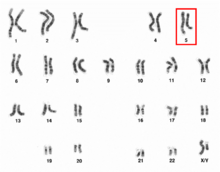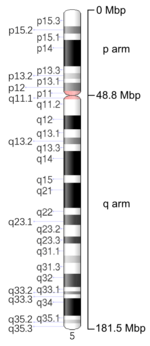Chromosome 5 (human)
| Chromosome 5 (human) | |
|---|---|
 Human chromosome 5 pair after G-banding. One is from mother, one is from father. | |
 Chromosome 5 pair in human male karyogram. | |
| Features | |
| Length (bp) | 181,538,259 bp |
| Number of genes | 1,892 |
| Type | Autosome |
| Centromere position | Submetacentric[1] |
| Identifiers | |
| RefSeq | NC_000005 |
| GenBank | CM000667 |

Chromosome 5 is one of the 23 pairs of chromosomes in humans. People normally have two copies of this chromosome. Chromosome 5 spans about 181 million base pairs (the building blocks of DNA) and represents almost 6% of the total DNA in cells. Chromosome 5 is the 5th largest human chromosomes, yet has one of the lowest gene densities. This is partially explained by numerous gene-poor regions that display a remarkable degree of non-coding and syntenic conservation with non-mammalian vertebrates, suggesting they are functionally constrained.[2]
Identifying genes on each chromosome is an active area of genetic research. Because researchers use different approaches to predict the number of genes on each chromosome, the estimated number of genes varies. Chromosome 5 likely contains between 900 and 1,300 genes.
Because chromosome 5 is responsible for many forms of growth and development (cell divisions) changes may cause cancers. One example would be acute myeloid leukemia (AML).[3]
Genes
The following are some of the genes located on chromosome 5:
- ABLIM3: encoding protein Actin-binding LIM protein 3
- ADAMTS2: ADAM metallopeptidase with thrombospondin type 1 motif, 2
- ANKRD31: encoding protein Ankyrin repeat domain 31
- APBB3: encoding protein Amyloid beta A4 precursor protein-binding family B member 3
- APC: adenomatosis polyposis coli
- C5orf3: encoding protein FAM114A2
- C5orf21/FAM172A: encoding protein UPF0528 protein FAM172A
- CAST: Calpastatin
- EGR1: early growth response protein 1
- ERAP1: endoplasmic reticulum aminopeptidase 1 (previously called ARTS-1)
- ERAP2: endoplasmic reticulum aminopeptidase 2
- DTDST: diastrophic dysplasia sulfate transporter
- ERCC8: excision repair cross-complementing rodent repair deficiency, complementation group 8
- FGFR4: fibroblast growth factor receptor 4
- GM2A: GM2 ganglioside activator
- HEXB: hexosaminidase B (beta polypeptide)
- HMGXB3: encoding protein HMG-box containing 3
- IRX1: Iroquois-class homeodomain protein (human)
- MASS1: monogenic, audiogenic seizure susceptibility 1 homolog (mouse)
- MCCC2: methylcrotonoyl-Coenzyme A carboxylase 2 (beta)
- MEF2C: Myocyte-specific enhancer factor 2C
- MTRR: 5-methyltetrahydrofolate-homocysteine methyltransferase reductase
- NIPBL: Nipped-B homolog (Drosophila)
- NSD1: Transcription coregulator protein
- Pikachurin: Responsible for the functioning of the ribbon synapses; allows the eye to track moving objects
- PURA: PURINE-RICH ELEMENT-BINDING PROTEIN A
- SLC22A5: solute carrier family 22 (organic cation transporter), member 5
- SLC26A2: solute carrier family 26 (sulfate transporter), member 2
- SH3TC2: domain and tetratricopeptide repeats 2
- SMN1: survival motor neuron 1, telomeric
- SMN2: survival motor neuron 2, centromeric
- SNCAIP: synuclein, alpha interacting protein (synphilin)
- SPINK5: serine protease inhibitor Kazal-type 5 (LEKTI)
- SPINK6: serine protease inhibitor Kazal-type 6
- SPINK9: serine protease inhibitor Kazal-type 9 (LEKTI-2)
- TCOF1: Treacher Collins-Franceschetti syndrome 1
- TGFBI: keratoepithelin
- TTC37: Tetratricopeptide repeat domain 37
- FGF1: fibroblast growth factor 1 (acidic fibroblast growth factor)
Diseases and disorders
The following are some of the diseases related to genes located on chromosome 5:
- Achondrogenesis type 1B
- Atelosteogenesis, type II
- Charcot–Marie–Tooth disease, type 4
- Cockayne syndrome
- Cornelia de Lange syndrome
- Corneal dystrophy of Bowman layer, type I
- Corneal dystrophy of Bowman layer, type II
- Cri du Chat
- Diastrophic dysplasia
- Ehlers-Danlos syndrome
- Ehlers-Danlos syndrome, dermatosparaxis type
- Familial adenomatous polyposis
- Granular corneal dystrophy type I
- Granular corneal dystrophy type II
- GM2-gangliosidosis, AB variant
- Homocystinuria
- 3-Methylcrotonyl-CoA carboxylase deficiency
- Myelodysplastic Syndrome
- Netherton syndrome
- Nicotine dependency
- Nipple Disease
- Parkinson's disease
- Primary carnitine deficiency
- Recessive multiple epiphyseal dysplasia
- Sandhoff disease
- Spinal muscular atrophy
- Sotos Syndrome
- Survival motor neuron spinal muscular atrophy
- Treacher Collins syndrome
- Tricho-hepato-enteric syndrome
- Usher syndrome
- Usher syndrome type II
Chromosomal conditions
The following conditions are caused by changes in the structure or number of copies of chromosome 5:
- Cri-du-chat syndrome is caused by a deletion of the end of the short (p) arm of chromosome 5. This chromosomal change is written as 5p-. The signs and symptoms of cri-du-chat syndrome are probably related to the loss of multiple genes in this region. Researchers have not identified all of these genes or determined how their loss leads to the features of the disorder. They have discovered, however, that a larger deletion tends to result in more severe mental retardation and developmental delays in people with cri-du-chat syndrome.[4][5][6]
- Researchers have defined narrow regions of the short arm of chromosome 5 that are associated with particular features of cri-du-chat syndrome. A specific region designated 5p15.3 is associated with a cat-like cry, and a nearby region called 5p15.2 is associated with mental retardation, small head (microcephaly), and distinctive facial features.
- Familial Adenomatous Polyposis is caused by a deletion of the APC tumor suppressor gene on the long (q) arm of chromosome 5. This chromosomal change results in thousands of colonic polyps which gives the patient a 100% risk of colon cancer if total colectomy is not done.
- Chromosome 5q deletion syndrome is caused by the deletion of the q arm (long arm) of chromosome 5. This deletion has been linked to several blood related disorders including Myelodysplastic syndrome and Erythroblastopenia. This is a different condition than Cri-du-chat which was mentioned above.
- Other changes in the number or structure of chromosome 5 can have a variety of effects, including delayed growth and development, distinctive facial features, birth defects, and other medical problems. Changes to chromosome 5 include an extra segment of the short (p) or long (q) arm of the chromosome in each cell (partial trisomy 5p or 5q), a missing segment of the long arm of the chromosome in each cell (partial monosomy 5q), and a circular structure called ring chromosome 5. A ring chromosome occurs when both ends of a broken chromosome are reunited.
References
- ↑ "Table 2.3: Human chromosome groups". Human Molecular Genetics (2nd ed.). Garland Science. 1999.
- ↑ Home - Homo sapiens
- ↑ "Chromosome 5". Genetics Home Reference. Lister Hill National Center for Biomedical Communications. U.S. National Library of Medicine. December 2014.
- ↑ Cornish K, Bramble D; Bramble (2002). "Cri du chat syndrome: genotype-phenotype correlations and recommendations for clinical management". Dev Med Child Neurol. 44 (7): 494–7. doi:10.1017/S0012162201002419. PMID 12162388.
- ↑ Wu Q, Niebuhr E, Yang H, Hansen L; Niebuhr; Yang; Hansen (2005). "Determination of the 'critical region' for cat-like cry of Cri-du-chat syndrome and analysis of candidate genes by quantitative PCR". Eur J Hum Genet. 13 (4): 475–85. doi:10.1038/sj.ejhg.5201345. PMID 15657623.
- ↑ Zhang X, Snijders A, Segraves R, Zhang X, Niebuhr A, Albertson D, Yang H, Gray J, Niebuhr E, Bolund L, Pinkel D; Snijders; Segraves; Zhang; Niebuhr; Albertson; Yang; Gray; Niebuhr; Bolund; Pinkel (2005). "High-resolution mapping of genotype-phenotype relationships in cri du chat syndrome using array comparative genomic hybridization". Am J Hum Genet. 76 (2): 312–26. doi:10.1086/427762. PMC 1196376
 . PMID 15635506.
. PMID 15635506.
- Mainardi PC, Perfumo C, Cali A, Coucourde G, Pastore G, Cavani S, Zara F, Overhauser J, Pierluigi M, Bricarelli FD; Perfumo; Calì; Coucourde; Pastore; Cavani; Zara; Overhauser; Pierluigi; Bricarelli (2001). "Clinical and molecular characterisation of 80 patients with 5p deletion: genotype-phenotype correlation". J Med Genet. 38 (3): 151–8. doi:10.1136/jmg.38.3.151. PMC 1734829
 . PMID 11238681.
. PMID 11238681. - Schafer IA, Robin NH, Posch JJ, Clark BA, Izumo S, Schwartz S; Robin; Posch; Clark; Izumo; Schwartz (2001). "Distal 5q deletion syndrome: phenotypic correlations". Am J Med Genet. 103 (1): 63–8. doi:10.1002/ajmg.1513. PMID 11562936.
- Schmutz J, Martin, Terry, Couronne, Grimwood, Lowry, Gordon, Scott, Xie, Huang, Hellsten, Tran-Gyamfi, She, Prabhakar, Aerts, Altherr, Bajorek, Black, Branscomb, Caoile, Challacombe, Chan, Denys, Detter, Escobar, Flowers, Fotopulos, Glavina, Gomez, et al. (2004). "The DNA sequence and comparative analysis of human chromosome 5". Nature. 431 (7006): 268–74. Bibcode:2004Natur.431..268S. doi:10.1038/nature02919. PMID 15372022.
- Siddiqi R, Gilbert F; Gilbert (2003). "Chromosome 5". Genet Test. 7 (2): 169–87. doi:10.1089/109065703322146902. PMID 12885343.
| Wikimedia Commons has media related to Human chromosome 5. |